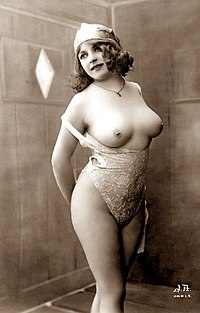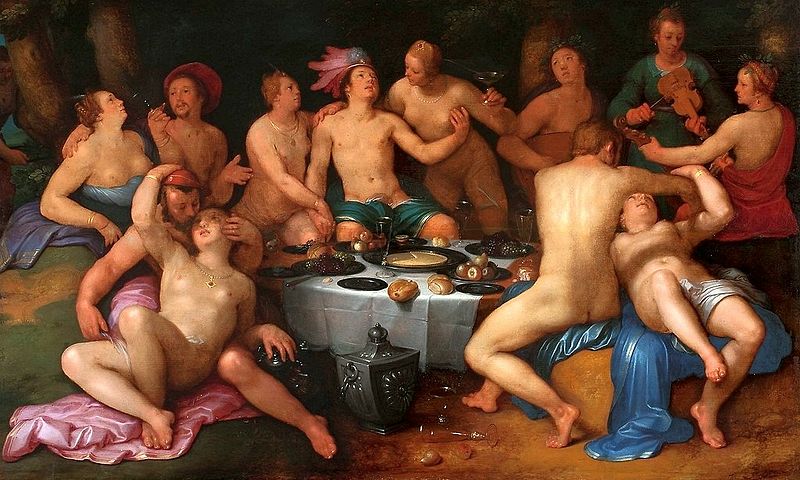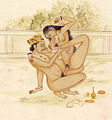Portal:Erotica and pornography
Introduction

Pornography (colloquially known as porn or porno) has been defined as sexual subject material "such as a picture, video, or text" that is intended for sexual arousal. Made for the consumption by adults, pornography depictions have evolved from cave paintings, some forty millennia ago, to virtual reality presentations. A general distinction of adult content is made classifying it as pornography or erotica.
The oldest artifacts considered pornographic were discovered in Germany in 2008 CE and are dated to be at least 35,000 years old. Throughout the history of erotic depictions, various people made attempts to suppress them under obscenity laws, censor, or make them illegal. Such grounds and even the definition of pornography have differed in various historical, cultural, and national contexts. The Indian Sanskrit text Kama Sutra (3rd century CE) contained prose, poetry, and illustrations regarding sexual behavior, and the book was celebrated; while the British English text Fanny Hill (1748), considered "the first original English prose pornography," has been one of the most prosecuted and banned books. In the late 19th century, a film by Thomas Edison that depicted a kiss was denounced as obscene in the United States, whereas Eugène Pirou's 1896 film Bedtime for the Bride was received very favorably in France. Starting from the mid-twentieth century on, societal attitudes towards sexuality became more lenient in the Western world where legal definitions of obscenity were made limited. In 1969, Blue Movie became the first film to depict unsimulated sex that received a wide theatrical release in the United States. This was followed by the "Golden Age of Porn" (1969–1984). The introduction of home video and the World Wide Web in the late 20th century led to global growth in the pornography business. Beginning in the 21st century, greater access to the Internet and affordable smartphones made pornography more mainstream. (Full article...)
Erotica is literature or art that deals substantively with subject matter that is erotic, sexually stimulating or sexually arousing. Some critics regard pornography as a type of erotica, but many consider it to be different. Erotic art may use any artistic form to depict erotic content, including painting, sculpture, drama, film or music. Erotic literature and erotic photography have become genres in their own right. Erotica also exists in a number of subgenres including gay, lesbian, women's, bondage, monster and tentacle erotica.
The term erotica is derived from the feminine form of the ancient Greek adjective: ἐρωτικός (erōtikós), from ἔρως (érōs)—words used to indicate lust, and sexual love. (Full article...)
Selected article
Jenna Haze (born 1982) is an American director, model, and former pornographic actress.
Haze has won numerous pornographic industry awards, including the 2003 AVN Award for Best New Starlet and the 2009 AVN Award for Female Performer of the Year, making her the second performer in history to ever win both awards in the course of her career, after Missy. In 2012, she was inducted into both the AVN and XRCO Halls of Fame. (Full article...)Selected work of erotic literature
The Kama Sutra (/ˈkɑːmə ˈsuːtrə/; Sanskrit: कामसूत्र, pronunciation, Kāma-sūtra; lit. 'Principles of Love') is an ancient Indian Hindu Sanskrit text on sexuality, eroticism and emotional fulfillment in life. Attributed to Vātsyāyana, the Kama Sutra is neither exclusively nor predominantly a sex manual on sex positions, but rather was written as a guide to the art of living well, the nature of love, finding a life partner, maintaining one's love life, and other aspects pertaining to pleasure-oriented faculties of human life. It is a sutra-genre text with terse aphoristic verses that have survived into the modern era with different bhāṣyas (exposition and commentaries). The text is a mix of prose and anustubh-meter poetry verses. The text acknowledges the Hindu concept of Purusharthas, and lists desire, sexuality, and emotional fulfillment as one of the proper goals of life. Its chapters discuss methods for courtship, training in the arts to be socially engaging, finding a partner, flirting, maintaining power in a married life, when and how to commit adultery, sexual positions, and other topics. The majority of the book is about the philosophy and theory of love, what triggers desire, what sustains it, and how and when it is good or bad.
The text is one of many Indian texts on Kama Shastra. It is a much-translated work in Indian and non-Indian languages. The Kamasutra has influenced many secondary texts that followed after the 4th-century CE, as well as the Indian arts as exemplified by the pervasive presence of Kama-related reliefs and sculpture in old Hindu temples. Of these, the Khajuraho in Madhya Pradesh is a UNESCO World Heritage Site. Among the surviving temples in north India, one in Rajasthan sculpts all the major chapters and sexual positions to illustrate the Kamasutra. According to Wendy Doniger, the Kamasutra became "one of the most pirated books in English language" soon after it was published in 1883 by Richard Burton. This first European edition by Burton does not faithfully reflect much in the Kamasutra because he revised the collaborative translation by Bhagavanlal Indrajit and Shivaram Parashuram Bhide with Forster Arbuthnot to suit 19th-century Victorian tastes. (Full article...)List of selected works
|
|---|
Slideshow of selected contemporary images
Slideshow of selected historical images
Did you know (auto-generated) -

- ... that the 1980s were the "age of hole-discovery" in yaoi erotica?
- ... that Christian radio station KIXL near Austin, Texas, pulled an anti-pornography program off-air in mid-transmission because of its graphic descriptions of gay sex?
- ... that in 2001, around 64 percent of all films produced in Malayalam were of the soft-porn variety?
- ... that women were 33 percent more likely than men to search for clown pornography on Pornhub in 2016?
- ... that the pastor John Littlejohn went from selling pornographic literature to sailors as a youth to protecting the Declaration of Independence?
- ... that Lewes Road in Brighton has a gyratory named after a pornographic cinema?
- ... that Philipp Tanzer has been an army medic, artist, firefighter, hairdresser, massage therapist, festival organiser, political candidate and gay porn star?
- ... that the nature documentary The Green Planet, narrated by David Attenborough, has been compared to both horror films and a "plant porno"?
Topics
Categories
Related portals
Associated WikiProjects
 |
 |
| Sexology and sexuality | Pornography |
Associated Wikimedia
The following Wikimedia Foundation sister projects provide more on this subject:
-
Commons
Free media repository -
Wikibooks
Free textbooks and manuals -
Wikidata
Free knowledge base -
Wikinews
Free-content news -
Wikiquote
Collection of quotations -
Wikisource
Free-content library -
Wikiversity
Free learning tools -
Wiktionary
Dictionary and thesaurus



































































![Image 14Indian Princess, by Richard Borrmeister [de] (1888?)](http://upload.wikimedia.org/wikipedia/commons/thumb/0/01/Richard_Borrmeister_Indische_Prinzessin_1888.jpg/102px-Richard_Borrmeister_Indische_Prinzessin_1888.jpg)






































